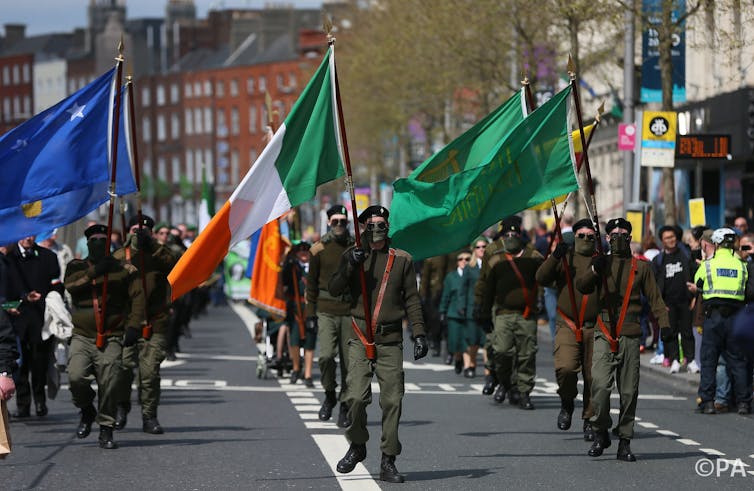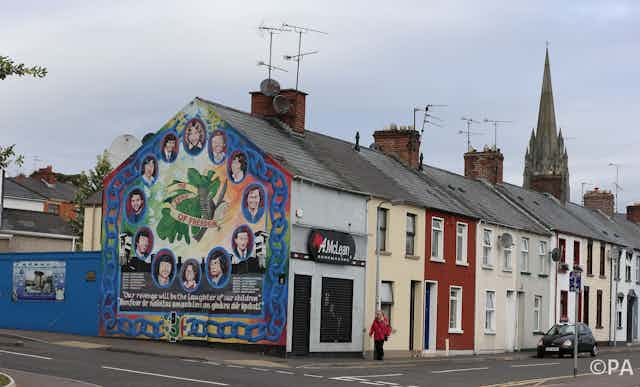It has been 21 years since Gerry Adams, president of Sinn Fein, voiced the famous soundbite that the IRA “haven’t gone away, you know”.
During two decades of relative peace in Northern Ireland, Irish republican violence has almost entirely fallen off the radar for the British public. Organisations such as Al Qaeda and Islamic State have long since been seen to pose a far greater security risk.
Yet the UK home secretary, Theresa May, announced that the official Northern Ireland-related terrorism threat has been raised from moderate to substantial in Britain. In Northern Ireland, the threat is rated as “severe”. This means that an attack in Britain is seen as a “strong possibility” and in Northern Ireland, an attack is “highly likely”.
All this evokes memories of the dark days between the 1970s and 1990s when a ring of steel was erected around London and the IRA brought the battle across the water. However this throwback to past decades has not just appeared out of the blue. It has been shaped by a number of factors, both historical and contemporary.
The threat has been building up in Northern Ireland for a number of years. There have been attacks on police and prison officers and the security forces fear the emergence of a new dissident super-group that brings together the various republican factions. If such a group emerged it would then lay claim to being the authentic face of the Irish republican tradition rather than the Provisional IRA.
Concern about this is particularly high in 2016. This year marks the centenary of the Easter Rising in Dublin – the armed insurrection against British rule that eventually paved the way for independence in 26 of Ireland’s 32 counties.

But it is also the date sold by Sinn Fein as the critical point in its contemporary ambitions for Irish reunification. And through much of the 1990s and early 2000s this goal appeared to be semi-realistic, if ambitious. Sinn Fein, the main voice of Irish republicanism, was on the rise at a time when the Catholic population was increasing too.
At the very least Sinn Fein and many political commentators anticipated that by 2016 close to 50% of the vote would be republican/nationalist. However, this vote began to stall at around the 42% mark in the mid 2000s. In the recent Northern Ireland Assembly elections, held on May 5, it fell back to 36%. That’s the worst combined share of the vote for these parties since the early 1990s.
The slide is partly due to voter apathy, but there also appears to have been an increase in Catholics voting for the Alliance Party, which now has eight seats in parliament. This group deems itself to be neither unionist or nationalist and has never been hostile to the idea of Irish unification by consent. There has also been an increase in people voting for parties such as the Greens and the People Before Profit Alliance.
The main reason for the drift away from nationalism and republicanism, however, appears to be the failure of Sinn Fein and the SDLP (the other main nationalist party in NI) to present a clear vision that reflects the aspirations of voters. They have not offered much on either bread-and-butter issues or a realistic approach to unification.
This has possibly also acted as a spark for the dissidents whose vision has always been clear and brutal. They want an end to British government involvement in Ireland, and the right of self-determination for their people. They do not believe Sinn Fein’s strategy is working and are prepared to resort to violence to achieve reunification. They know very well that attacks in Britain will generate hysteria and division. Such attacks might also generate forms of repression that will harden attitudes among Northern Ireland’s Catholics, as happened in the 1970s after such events as the Guildford pub bombings.
Loss of support
Times are different though. My own research due to be published later this year suggests relative happiness with the status quo of power sharing among today’s Northern Irish Catholics. It seems that although 80% of them, including some Alliance Party voters, still aspire to a united Ireland, they don’t want to see it happen through violence. There simply isn’t an appetite for violence or any immediate demand for unification among the Irish nationalist population, north or south of the border.
Unfortunately, the harsh reality is that within the tradition of physical force republicanism there is a belief that a mandate for violence is not required. They cling to those events of 1916, where an apathetic Irish population was roused into calling for independence after the British overreacted to the insurrection in Dublin. Maybe it is important, then, for the rest of Britain to heed the lessons of history too – and not overreact to the decision to raise the terror threat.
The solution will not be found in any ring of steel around London. It will have to be found in the long term by the political parties and the people of Northern Ireland.

